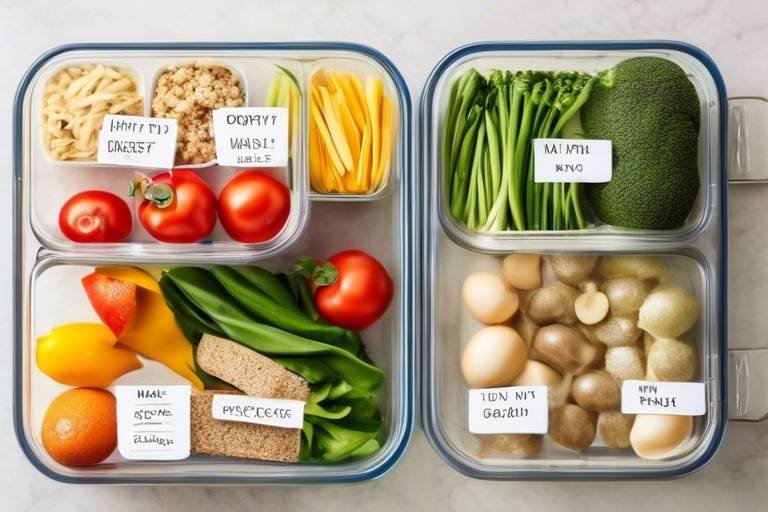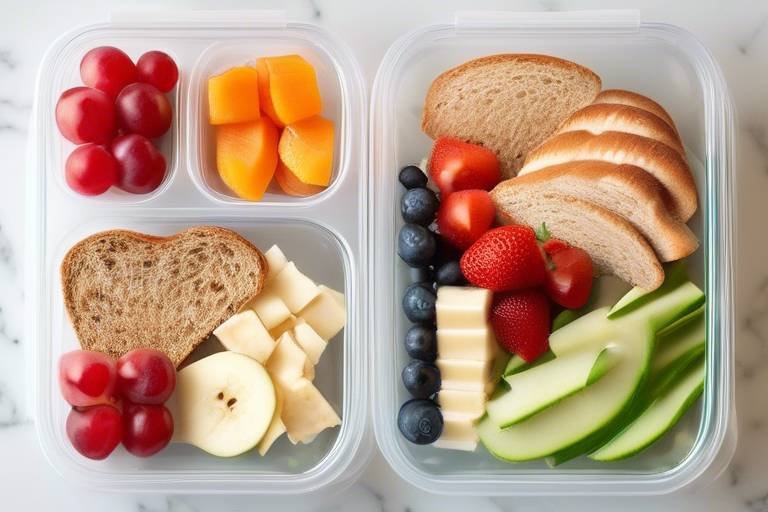The Importance of Family Dinners for Child Nutrition
In today's fast-paced world, where everyone seems to be racing against time, the concept of family dinners often takes a back seat. However, the significance of gathering around the dinner table cannot be overstated, especially when it comes to child nutrition. Family dinners are more than just an opportunity to eat; they are a vital ritual that fosters connections, promotes healthy eating habits, and enhances the overall well-being of children.
Imagine this: a warm, inviting table set with a colorful array of dishes, the aroma of home-cooked meals wafting through the air, and laughter echoing as family members share stories about their day. This scene doesn't just create a pleasant atmosphere; it plays a crucial role in shaping a child's relationship with food. When children dine with their families, they are not only consuming nutrients but are also absorbing valuable lessons about nutrition, communication, and social skills.
Research has shown that children who regularly participate in family dinners are more likely to consume fruits and vegetables, have a healthier overall diet, and exhibit fewer behavioral issues. Moreover, these meals provide a platform for parents to model healthy eating behaviors, making it easier for children to adopt similar habits. When kids see their parents enjoying a variety of foods, they are more inclined to explore those foods themselves.
Furthermore, family dinners serve as a safe space for children to express themselves and engage in meaningful conversations. These interactions help build communication skills and foster emotional connections among family members. In an age where technology often distracts us from genuine interactions, mealtime offers a unique opportunity to unplug and reconnect with each other.
As we delve deeper into the benefits of family dinners, it becomes evident that these gatherings are not merely about food; they are about nurturing the mind, body, and spirit of each family member. By prioritizing family meals, we are investing in our children's future, ensuring they develop healthy habits that will last a lifetime.
Family dinners offer numerous advantages, including improved nutrition, better communication, and strengthened family bonds. These meals serve as an opportunity for children to learn about healthy eating habits and social skills.
Planning nutritious meals is essential for child development. This section discusses how to create balanced meals that incorporate essential food groups while appealing to children's tastes and preferences.
Including a variety of fruits and vegetables in family dinners is crucial for children's health. This subsection highlights creative ways to make these foods more appealing and enjoyable for kids.
Engaging children in fun cooking activities can encourage them to try new fruits and vegetables. This section provides ideas for interactive cooking experiences that the whole family can enjoy together.
The way food is presented can significantly impact children's willingness to try new foods. This section shares tips for making healthy dishes visually appealing and exciting for young diners.
Family dinners are an excellent opportunity to instill healthy eating habits in children. This subsection discusses strategies to encourage mindful eating and positive food choices during mealtime.
Regular family dinners help strengthen relationships among family members. This section emphasizes the importance of communication and quality time during meals, contributing to emotional well-being.
A positive mealtime atmosphere fosters open communication and connection. This subsection provides tips for making family dinners enjoyable and stress-free, allowing for meaningful conversations.
Many families face challenges when trying to maintain regular family dinners. This section addresses common obstacles and offers practical solutions to help families prioritize mealtime together.
The habits formed during family dinners can have lasting effects on children’s nutritional choices and social skills. This section explores the long-term benefits of consistent family meals on child development.
Q: How often should families have dinner together?
A: Ideally, families should aim for at least three to five family dinners per week to reap the benefits of shared meals.
Q: What if family members have different dietary preferences?
A: It's essential to accommodate various preferences by offering a range of options during meals. Encourage everyone to contribute to meal planning.
Q: How can we make family dinners more enjoyable?
A: Create a positive atmosphere by minimizing distractions, encouraging conversation, and involving everyone in the cooking process.

Benefits of Family Dinners
Family dinners are more than just a time to eat; they are a vital part of a child’s development and well-being. When families gather around the dinner table, they create a space where communication flows freely, and connections deepen. This ritual offers numerous advantages that extend beyond simply filling bellies. One of the most significant benefits is improved nutrition. Studies have shown that children who regularly partake in family meals consume more fruits, vegetables, and whole grains, which are essential for their growth and development. Moreover, these meals provide an opportunity for parents to model healthy eating habits, encouraging children to make better food choices.
But it’s not just about the food; family dinners foster better communication among family members. It’s a time to share stories, discuss daily events, and express feelings. This open dialogue helps children develop important social skills and emotional intelligence. When children feel heard and valued during these mealtimes, it strengthens their sense of belonging and self-esteem. Additionally, regular family dinners can lead to stronger family bonds, creating a supportive environment where children feel safe to explore and express themselves.
Furthermore, family dinners are a fantastic way to teach children about table manners and etiquette. As they observe their parents and siblings, they learn how to interact socially, which is crucial for their future relationships. In essence, these meals serve as a mini classroom where children can absorb valuable life skills while enjoying delicious food.
In summary, the benefits of family dinners are multifaceted. They not only enhance nutrition but also promote communication and strengthen family ties. By prioritizing family meals, parents can play an active role in their children’s development, setting the foundation for a lifetime of healthy habits and strong relationships.

Nutrition and Meal Planning
When it comes to raising healthy children, are like the secret ingredients in a delicious recipe. Just like a chef carefully selects the best produce and spices, parents need to thoughtfully plan meals that not only taste great but also nourish growing bodies. The key is to create a balanced diet that incorporates essential food groups while also appealing to children’s tastes and preferences. After all, getting kids to eat their veggies can sometimes feel like trying to convince a cat to take a bath! So, how do we make it easier?
First off, think about the food groups that should be included in a child's diet. A well-rounded meal typically consists of:
| Food Group | Examples |
|---|---|
| Fruits | Apples, Bananas, Berries |
| Vegetables | Carrots, Spinach, Broccoli |
| Proteins | Chicken, Fish, Beans |
| Grains | Rice, Quinoa, Whole Wheat Bread |
| Dairy | Milk, Yogurt, Cheese |
By incorporating a variety of foods from these groups, you’re setting the stage for your child to develop healthy eating habits. But how do you make sure these meals are appealing? One effective strategy is to involve your children in the meal planning process. Ask them what fruits and vegetables they enjoy, and let them help select recipes. This not only gives them a sense of ownership but also makes them more likely to try new foods.
Another important aspect is to introduce meals that are colorful and visually appealing. Picture a plate filled with vibrant greens, rich reds, and sunny yellows. It’s like a rainbow on a plate! You might be surprised at how much more willing children are to try something new when it looks fun. For instance, you could create a fruit salad that includes a mix of strawberries, blueberries, and kiwi, or a stir-fry with a variety of colorful vegetables. The more inviting the dish, the more likely they are to dig in.
Don’t forget to consider portion sizes as well. Children have smaller stomachs, so serving them smaller portions can help prevent overwhelming them. You can always offer seconds if they’re still hungry. This approach not only promotes mindful eating but also helps children learn to listen to their bodies when it comes to hunger and fullness.
Finally, remember that meal planning doesn’t have to be a chore. It can be a fun family activity! Set aside some time each week to brainstorm meals together, shop for ingredients, and even cook as a team. This not only makes the process enjoyable but also teaches children valuable skills that they will carry into adulthood.
Q: How can I make sure my child gets enough nutrients?
A: Focus on providing a variety of foods from all the food groups. Incorporate fruits, vegetables, whole grains, proteins, and dairy into their meals. You can also consult a pediatrician or a nutritionist for personalized advice.
Q: What if my child is a picky eater?
A: Try to be patient and persistent. Offer new foods alongside familiar ones, and involve your child in meal preparation. Sometimes, just seeing a food being prepared can spark their interest in trying it!
Q: How can I make family meals more enjoyable?
A: Create a relaxed atmosphere during mealtime. Turn off distractions like TVs and phones, and encourage open conversations. You can also make it fun by having themed dinners or cooking challenges!

Incorporating Fruits and Vegetables
When it comes to child nutrition, incorporating fruits and vegetables into family dinners is not just important—it's essential. These vibrant foods are packed with vitamins, minerals, and antioxidants that are crucial for growing bodies. But let’s face it: getting kids to eat their greens can sometimes feel like pulling teeth! So, how can we make fruits and veggies more appealing to our little ones? The key is to get creative and make these foods fun and exciting.
One effective strategy is to involve children in the cooking process. When kids help prepare meals, they are more likely to try new foods. For instance, you can have a family cooking night where everyone pitches in. Whether it’s washing, chopping, or stirring, kids love being part of the action. You could even create a “Rainbow Dinner” theme, where each family member chooses a different colored fruit or vegetable to include in the meal. Not only does this make for a visually stunning plate, but it also encourages kids to explore a variety of flavors and textures.
Another fun way to incorporate more fruits and vegetables is through creative presentation. Kids are often more inclined to eat something that looks interesting. Try arranging vegetables into fun shapes or creating a colorful fruit salad that resembles a work of art. For example, you can use cookie cutters to make star-shaped cucumbers or create a fruit kabob with colorful chunks of pineapple, strawberries, and grapes. The more visually appealing the dish, the more likely kids will be to give it a try!
Additionally, consider introducing fruits and vegetables in unexpected ways. For example, smoothies are a fantastic way to sneak in some greens without kids even noticing. Blend spinach or kale with bananas and yogurt for a delicious treat that’s packed with nutrients. You can also bake vegetables into muffins or pancakes, turning ordinary breakfasts into health-boosting meals. It’s all about thinking outside the box!
Lastly, remember to lead by example. Children are like little sponges; they soak up everything they see. If they see you enjoying a variety of fruits and vegetables, they are more likely to want to try them too. Make it a family challenge to try a new fruit or vegetable each week and discuss what everyone thinks about it. This not only fosters a sense of adventure around food but also creates lasting memories around the dinner table.
Incorporating fruits and vegetables into family dinners is not just about nutrition; it's about making healthy eating a fun and enjoyable experience. By involving children in the cooking process, presenting food creatively, introducing foods in unexpected ways, and setting a positive example, you can cultivate a love for healthy eating that lasts a lifetime.
- How can I encourage my child to eat more vegetables? Try involving them in meal prep or making vegetables fun with creative presentations.
- What are some easy ways to incorporate fruits into meals? Smoothies, fruit salads, and desserts like yogurt parfaits are great options!
- Are frozen fruits and vegetables as nutritious as fresh ones? Yes! Frozen options can be just as nutritious and are often more convenient.

Fun Cooking Activities
Cooking together as a family can be an incredibly enriching experience that not only teaches children essential skills but also makes healthy eating more enjoyable. Imagine the laughter and joy that fills the kitchen as everyone gets involved in creating a delicious meal! It’s not just about the food; it’s about the memories you create along the way. Here are some engaging activities you can do together:
One exciting way to get kids involved is through themed cooking nights. For instance, you could have a "Taco Tuesday" where everyone can customize their tacos with various toppings. This not only allows children to choose their ingredients but also introduces them to different flavors and textures. You can even turn it into a friendly competition, where each family member creates their own unique taco, and everyone votes for their favorite!
Another fun activity is to host a family cooking challenge. Set a timer and see who can create the best dish using a selection of ingredients you provide. This can spark creativity and innovation, as kids learn to think on their feet and make the most of what they have. Plus, it’s a fantastic way to encourage them to try new foods, as they will be more inclined to taste what they’ve made themselves.
Don't forget about the power of hands-on experience. Kids love to get their hands dirty, so let them help with washing vegetables, mixing ingredients, or even kneading dough. The tactile experience can make them more interested in the food they’re preparing. You can explain the importance of each ingredient as you go along, turning cooking into a fun learning opportunity.
Additionally, consider creating a family recipe book. Each week, you can choose a recipe to try, and after cooking it together, write it down in your book along with any modifications or tips you discovered while making it. This not only serves as a lovely keepsake but also encourages children to take ownership of their cooking journey.
Finally, don’t underestimate the joy of decorating food. Whether it's making funny faces on pancakes with fruits or arranging vegetables into fun shapes, let your kids unleash their creativity. This can make healthy foods more appealing and encourage them to eat what they might usually shy away from. Remember, the goal is to make cooking a fun and memorable family affair!
- How often should we have family dinners?
Ideally, aim for at least three to four times a week to build a routine that everyone can look forward to. - What if my kids are picky eaters?
Involve them in the cooking process and let them choose ingredients to increase their interest in trying new foods. - Can family dinners really improve communication?
Yes! Regular meals together provide a relaxed atmosphere for open discussions and sharing of daily experiences. - What are some quick meal ideas for busy families?
Consider stir-fries, pasta dishes, or tacos, which can be prepared quickly and allow for customization.

Creative Presentation Ideas
When it comes to making healthy meals for your kids, the presentation can be just as important as the taste. After all, we eat with our eyes first! If the food looks appealing, children are more likely to give it a try. So, how can you transform a simple plate of vegetables into a culinary masterpiece that excites your little ones? Here are some that can make mealtime a fun and engaging experience.
One effective strategy is to create food art. This can involve arranging fruits and vegetables into fun shapes or characters that catch the eye. For example, you can slice cucumbers and arrange them to look like a caterpillar, using cherry tomatoes for the head. Or, you can use a variety of colorful fruits to create a rainbow on the plate. Not only does this make the meal visually appealing, but it also encourages kids to explore different flavors and textures.
Another idea is to use themed meals. You can have a “Taco Night” where everyone builds their own tacos, or a “Pizza Party” where kids can add their favorite toppings. This interactive approach not only makes the food more appealing but also gives children a sense of control over their meal choices, making them more likely to eat what they prepare.
Consider using colorful plates and utensils to make the dining experience more vibrant. Brightly colored dishware can make even the most basic meals look exciting. You might also try serving food in fun containers, like bento boxes, which can be filled with a variety of healthy options. The compartmentalized nature of bento boxes allows for a visual feast, showcasing a rainbow of fruits, veggies, and proteins all in one place.
Moreover, think about the height of your food presentation. Stacking ingredients can add dimension to your meals. For instance, when serving a sandwich, try skewering it with a colorful toothpick or cutting it into fun shapes. Building a veggie tower with layers of sliced bell peppers, cucumbers, and cherry tomatoes can also spark curiosity and make healthy eating an adventure.
Lastly, don’t underestimate the power of dipping sauces. Kids love to dip! Presenting a variety of colorful dips, such as hummus, guacamole, or yogurt-based sauces, can make vegetables much more enticing. You can even create a “dip bar” where kids can choose their favorite sauces to accompany their veggies, making it a fun and interactive experience.
In conclusion, the way you present food can significantly influence your child's willingness to try new and healthy options. By incorporating these creative presentation ideas, you can turn family dinners into exciting culinary adventures that not only nourish their bodies but also ignite their imaginations.
Q: How can I encourage my child to eat more vegetables?
A: Try making vegetables visually appealing through creative presentation, such as food art or colorful plates. Involve your child in meal preparation to make them more interested in trying new foods.
Q: What are some fun themes for family dinners?
A: You can have taco nights, pizza parties, or even international cuisine nights where each family member picks a dish from a different country.
Q: How can I make healthy eating a habit for my child?
A: Consistency is key! Regular family dinners where healthy meals are served can help instill good eating habits. Additionally, creating a positive and engaging atmosphere during meals can encourage children to make better food choices.

Encouraging Healthy Eating Habits
Family dinners provide a golden opportunity to instill healthy eating habits in children. It’s more than just putting food on the table; it’s about creating an environment where good nutrition is both a priority and a norm. But how do we go about this? It starts with making mealtime a mindful experience. Encourage your kids to savor each bite, discussing the flavors and textures of the food. This not only enhances their appreciation for what they eat but also helps them recognize when they’re full.
Incorporating discussions about food choices during family dinners can also be a game-changer. For instance, you might ask questions like, “What do you think makes this meal healthy?” or “How do we think this food helps our bodies?” By engaging them in conversation, you’re not just feeding them; you’re teaching them. It’s like planting seeds of knowledge that will grow into lifelong healthy eating habits.
Another effective strategy is to involve children in the meal preparation process. When kids help in the kitchen, they’re more likely to take an interest in what they’re eating. They can help choose recipes, wash vegetables, or even mix ingredients. This hands-on experience can make them more excited about trying new foods. Plus, it’s a fantastic way to bond as a family. Think of it as a culinary adventure where everyone plays a part!
Additionally, creating a positive food environment is crucial. This means having healthy options readily available at home and making sure that meals are a pleasant experience. Avoid distractions like television or smartphones during dinner to focus on each other and the food. You might even want to establish a no-pressure policy: if a child doesn’t want to eat a certain food, that’s okay! Encourage them to try just one bite instead. This approach can significantly reduce the stress around mealtime and make children more willing to experiment with different foods.
To further reinforce healthy eating habits, consider introducing a fun food challenge at the dinner table. For example, challenge your family to try a new fruit or vegetable each week. You could even create a colorful chart to track everyone’s progress. This not only adds an element of excitement to mealtime but also encourages kids to explore a variety of nutrients.
Lastly, remember that consistency is key. Regular family dinners where healthy choices are emphasized will gradually shape your children’s attitudes towards food. As they grow, the lessons learned around the dinner table will stick with them, influencing their food choices for years to come. It’s all about creating a nurturing environment where healthy eating becomes second nature.
- Why are family dinners important for children's nutrition? Family dinners provide a structured setting for children to learn about healthy eating habits and social skills, promoting better nutrition overall.
- How can I make vegetables more appealing to my kids? Try involving them in the cooking process, presenting the food creatively, or introducing fun cooking activities to spark their interest.
- What if my child refuses to eat certain foods? Encourage them to try just one bite without pressure. Creating a positive atmosphere can help reduce resistance to new foods.
- How often should we have family dinners? Aim for at least a few times a week, as regular mealtime together can strengthen family bonds and reinforce healthy eating habits.

Building Family Connections
Regular family dinners are not just about food; they are a foundation for building strong family connections. When families gather around the dinner table, it creates a unique opportunity for members to engage with one another, share experiences, and strengthen their bonds. Think of it as a daily ritual where everyone can come together to unwind and connect after a busy day. Have you ever noticed how conversations flow more freely during meals? That’s the magic of family dinners!
During these meals, communication becomes a natural part of the experience. Children learn to express themselves and listen to others, which is crucial for their emotional and social development. The dinner table can become a safe space where opinions can be shared without judgment, and where family members can support one another. This is especially important for children as they develop their own identities and learn how to navigate relationships outside the home.
Moreover, family dinners foster a sense of belonging. When children see their parents and siblings engaging in conversations, laughing, and sharing stories, they feel valued and understood. This emotional connection is vital for their self-esteem and can lead to healthier relationships in the future. It's like planting seeds of love and trust that will grow as they mature.
To enhance these connections, consider implementing a few strategies that can make family dinners even more enjoyable:
- Theme Nights: Create themed dinners where everyone can participate in the planning and preparation. It could be as simple as “Taco Tuesdays” or “Pasta Night.” This not only makes meals exciting but also involves everyone in the process.
- Conversation Starters: Keep the dialogue flowing with fun conversation starters. You could ask questions like, “If you could have any superpower, what would it be?” This encourages creativity and laughter, making the atmosphere light and enjoyable.
- Technology-Free Zone: Make the dining table a technology-free zone. This means no phones, tablets, or TVs. This simple rule can lead to deeper conversations and a more meaningful connection among family members.
Creating a positive mealtime atmosphere is essential. When the environment is relaxed and enjoyable, everyone feels more inclined to engage. It’s important to keep the mood light and avoid heavy topics that might lead to stress or conflict. Instead, focus on sharing funny stories or discussing upcoming family plans. Remember, the goal is to create lasting memories that everyone can cherish.
Of course, maintaining regular family dinners can come with its own set of challenges. Busy schedules, differing tastes, and even logistical issues can make it difficult to sit down together. However, overcoming these obstacles is crucial. Prioritizing family time can mean the difference between a fragmented family life and a close-knit one. Consider setting a specific day of the week as “Family Dinner Night” and stick to it. Consistency is key!
In conclusion, the importance of through regular dinners cannot be overstated. These moments of togetherness are invaluable for fostering communication, emotional support, and a sense of belonging. So, why not make it a priority to gather around the table? You might just find that these simple meals turn into the most cherished moments of your family life.

Creating a Positive Atmosphere
Creating a positive atmosphere during family dinners is essential for fostering open communication and strengthening connections among family members. Think about it: how can we truly connect if the mood is tense or distracted? By setting the right tone at the dinner table, we create a space where everyone feels comfortable sharing their thoughts and experiences. This can be achieved through a few simple yet impactful strategies.
First and foremost, consider the environment in which you dine. A clutter-free table, soft lighting, and perhaps some background music can transform a typical meal into a delightful experience. Imagine sitting down to a warm, inviting table where the aroma of home-cooked food fills the air. It’s not just about the food; it’s about the ambiance that encourages family members to engage in meaningful conversations.
Moreover, it’s crucial to establish a no-device policy during meals. In today's digital age, distractions are everywhere, and it’s easy to lose focus on the people right in front of us. By putting away phones and tablets, families can fully immerse themselves in each other's company. This simple act can lead to richer discussions and deeper connections, making the dinner experience much more rewarding.
Another key aspect is to encourage everyone to participate in the conversation. This can be as simple as asking each family member about their day or sharing something interesting they learned recently. You might even consider introducing a fun question of the day, which can spark lively discussions. For example, "If you could have dinner with any historical figure, who would it be and why?" This not only makes the meal more engaging but also helps children develop their communication skills.
To further enhance the atmosphere, consider incorporating family traditions. Whether it’s a special recipe passed down through generations or a fun ritual like sharing jokes before the meal, these traditions create a sense of belonging and continuity. Children thrive on routine, and knowing that family dinners are a cherished time can motivate them to participate eagerly.
Lastly, remember to keep the tone light and positive. While it’s natural to discuss challenges and concerns, try to balance these conversations with uplifting stories and laughter. A light-hearted atmosphere can make even the most mundane topics enjoyable. When children associate family dinners with warmth and joy, they are more likely to look forward to these gatherings and develop a love for healthy eating.
- How can I encourage my child to talk more during dinner? Encourage open-ended questions and share your own stories to create a comfortable dialogue.
- What if my family has different schedules? Try to set at least one day a week where everyone can commit to having dinner together.
- How can I make family dinners more fun? Incorporate games or themed dinners to make the experience exciting and engaging.

Overcoming Challenges
Life can get busy, can't it? Between work, school, extracurricular activities, and social commitments, finding time for family dinners can feel like an uphill battle. But here's the good news: you’re not alone in this struggle, and there are practical ways to make family meals a reality, even in the busiest of times. First, let’s acknowledge some common challenges families face:
- Time Constraints: With everyone’s schedules packed, it can be tough to coordinate a time when everyone is free.
- Picky Eaters: Children can be notoriously selective about what they eat, which can make meal planning a headache.
- Fatigue: After a long day, the last thing you might want to do is cook a big meal.
Now, let’s tackle these challenges head-on. For time constraints, consider setting a specific day or two each week dedicated to family dinners. You could even make it a fun event by theme nights, like Taco Tuesday or Pizza Friday, which can simplify meal prep and make it something everyone looks forward to. Using a weekly meal planner can also help streamline your grocery shopping and cooking process, saving you precious time during the week.
When it comes to picky eaters, involving your children in the meal planning process can work wonders. Ask them to choose a fruit or vegetable they’d like to try, or let them help with the cooking. This not only gives them a sense of ownership over their meals but also makes them more likely to taste new things. Remember, the key is to present these foods in a fun and exciting way. You can create colorful plates or even arrange food into fun shapes—kids love that!
Feeling fatigued after a long day? You’re not alone! To combat this, consider preparing meals in advance. Batch cooking on weekends can free up your evenings, allowing you to simply heat up a nutritious meal when the time comes. Additionally, quick and easy recipes can be lifesavers. Think stir-fries, sheet pan dinners, or one-pot meals that require minimal cleanup.
Finally, let’s not forget about the emotional and social aspect of family dinners. Even if you can only gather for a quick meal, make the most of that time. Keep the atmosphere light and fun—ask about each other's day, share stories, and laugh together. These small moments can have a big impact on family bonding.
In conclusion, while challenges are inevitable, they can also be overcome with a little creativity and planning. By prioritizing family dinners, you’re not just nourishing your children’s bodies; you’re also nurturing their minds and hearts. So, roll up your sleeves, get the family involved, and make mealtime a cherished tradition!
1. How often should we have family dinners?
It's recommended to aim for at least three to four family dinners a week. However, even one dedicated family meal can make a significant difference in your family's connection.
2. What if my child refuses to eat healthy foods?
Encourage them to try new foods by involving them in meal preparation and presentation. Make it fun and engaging, and be patient—sometimes, it takes multiple exposures for children to accept new foods.
3. How can I manage busy schedules and still have family dinners?
Plan ahead! Choose specific days for family dinners, and consider batch cooking or preparing simple meals that can be made quickly. Communication is key—coordinate with family members to find times that work for everyone.

Long-term Impact on Children
When it comes to child development, the impact of family dinners extends far beyond the dining table. Regular family meals can shape children's nutritional choices and social skills in profound ways. Think about it: when children sit down with their families for dinner, they are not just consuming food; they are absorbing lessons about healthy eating, communication, and emotional well-being. The habits formed during these meals can stick with them for a lifetime, influencing their choices well into adulthood.
Research shows that children who participate in family dinners tend to have better nutritional habits. They are more likely to eat fruits and vegetables, whole grains, and lean proteins—foods that are essential for their growth and development. In fact, a study conducted by the National Center on Addiction and Substance Abuse found that children who share regular family meals are less likely to engage in unhealthy behaviors, such as smoking or drinking. It’s like a protective shield that fosters not just good nutrition but also positive lifestyle choices.
Moreover, family dinners provide a unique opportunity for children to learn essential social skills. During these meals, they engage in conversations, share stories, and navigate discussions, all of which are crucial for developing effective communication skills. This interaction helps them understand the nuances of social cues and emotional intelligence, equipping them to handle various social situations outside the home. Imagine a child who grows up discussing their day at dinner—this simple act can transform them into confident communicators and empathetic listeners.
The long-term benefits of family dinners can also be seen in emotional health. Children who regularly share meals with their families report feeling more connected and secure. This emotional bond nurtures a sense of belonging and support, which is vital during the tumultuous years of adolescence. As they grow older, these children are likely to carry forward the values of connection and communication, fostering healthier relationships in their own lives.
Additionally, let’s not forget the role of family dinners in establishing a routine. Children thrive on structure, and having regular mealtimes can provide a sense of stability in their lives. This consistency not only promotes better eating habits but also helps them develop self-discipline and time management skills. By understanding the importance of family dinners, parents can encourage their children to prioritize family time, even when life gets hectic.
In summary, the long-term impact of family dinners on children is multifaceted. From improved nutrition and enhanced social skills to emotional well-being and structured routines, the benefits are undeniable. As families navigate the challenges of modern life, prioritizing these shared meals can create a foundation for healthier and happier futures.
- How often should families have dinner together? Ideally, families should aim for at least three to four dinners together each week to maximize the benefits.
- What if our schedules are too busy for family dinners? Consider setting aside one night a week as a dedicated family dinner night. Consistency is key!
- Can family dinners help with picky eaters? Yes! Involving children in meal planning and preparation can make them more open to trying new foods.
- What are some easy meals for busy families? Quick and healthy options include stir-fries, pasta dishes, and sheet pan meals that require minimal prep time.
Frequently Asked Questions
- Why are family dinners important for child nutrition?
Family dinners play a crucial role in child nutrition as they provide a structured time for children to consume balanced meals. Eating together encourages better food choices, introduces children to a variety of healthy foods, and helps them develop positive eating habits that can last a lifetime.
- How can I make family dinners more appealing for my kids?
Making family dinners appealing can be as simple as involving your kids in the meal preparation. Let them pick out fruits and vegetables at the store or help with cooking. Additionally, presenting the food in fun and creative ways can make it more exciting. Think of colorful plates or fun shapes!
- What are some strategies for overcoming challenges to regular family dinners?
To overcome challenges like busy schedules, try to designate a specific day or time each week for family dinners. Even if it’s just one night, make it a priority. If it’s tough to gather everyone, consider a simple meal that doesn’t require much preparation, ensuring that family time remains the focus.
- How can I encourage my children to try new foods during dinner?
Encouraging kids to try new foods can be fun! Create a 'food adventure' night where everyone tries something new. You can also use peer influence by inviting friends over for dinner or making it a game where kids earn points for trying new foods!
- What long-term benefits do family dinners have on children?
The long-term benefits of family dinners include improved nutritional choices, better communication skills, and stronger family bonds. Children who regularly participate in family meals are more likely to develop healthy eating habits and exhibit greater emotional well-being as they grow older.
- How can I create a positive atmosphere during family dinners?
Creating a positive atmosphere involves setting the right tone for mealtime. Keep the conversation light and engaging, avoid distractions like phones or TV, and encourage everyone to share their day. It’s all about making the meal a joyful experience where everyone feels included!



















